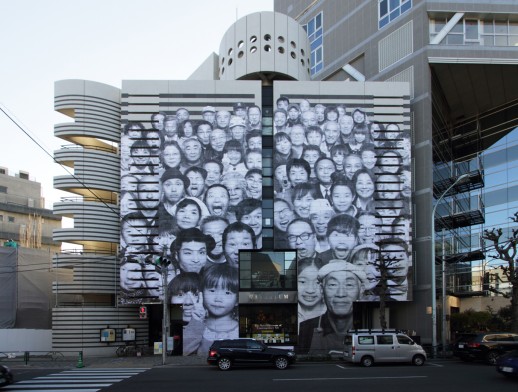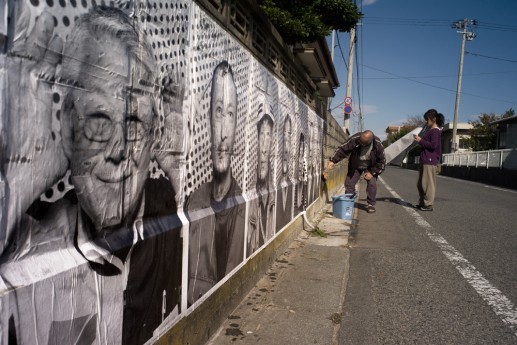A New Face for Fukushima

Urban art tends to work best in a contemporary art gallery when the artist treats it not as an isolated space hosting frames to be filled, but as an extension of their traditional workplace–the street. Perhaps the most successful example so far has been the British graffiti artist, Banksy’s, 2011 faux vandalization of the Bristol Museum’s classical art collection, in which he augmented Italian renaissance sculptures with luxury brand shopping bags or suicide bomb vests and added a budget airline advert to Claude Derain’s The Flight to Egypt. French artist JR’s latest show in Tokyo—a city that appears hostile to most street art—initially seems to employ a similar invasion-not-exhibition aesthetic, with the entire 4-story front of Watari-um covered with the artist’s signature large-scale monochrome portraits. The first artworks in the gallery also continue this theme as they are displayed within spray-painted frames or applied directly to the walls. On descending through the building’s four exhibition floors, however, it soon becomes clear that JR is less concerned with working inside the aesthetic, cultural, or rebellious conventions of street art, than he is passionate about its tradition of social engagement.
“JR: Could Art Change the World?” serves as a concise retrospective of the 30-year old’s career so far, covering his internationally renowned art projects in places of the world that are linked by their reputations as ‘no-go’ areas – Paris’ notorious housing estates (Portrait of a Generation, 2004-2006); the Gaza Strip (Face2face, 2007); and the favelas of Rio (Women are Heroes, 2008-10). The images on display from the former series depict residents from the Parisian estate, La Forestière, which bore the brunt of the infamous 2004 riots in the French capital. The black-and-white portraits, shot mainly in close-up and often with a fish-eye lens, show the subjects grinning and pulling funny faces; forcing all but the most serious gallery-goers to return the smile. And what more visible emotional reaction could an artist hope to evoke from their viewer? JR printed and recontextualized these shots, flyposting them onto the public walls of more affluent Parisian neighborhoods, thus providing a powerful counter image to the French media’s riot coverage, which depicted only angry ethnic minorities hell-bent on destruction. In JR’s posters, the youth of La Forestière can be in the thoughts of Parisian middle classes for a second time—not through their aggression but through their varying expressions of humanity.
It is with similar intent then that, in 2012, JR initiated a new project in the areas of northeast Japan that were afflicted by the earthquake, tsunami, and nuclear disaster. As part of his wider Inside Out Project, a Japanese photography team toured the area in a truck equipped with an adapted photo booth and large format printer. They made more than 400 portraits of a diverse group of local people and fly-posted them around the afflicted towns, most eerily so on the side of a marooned fishing vessel swept 800 meters inland by the tsunami.
The Watari-um dedicates its ground floor to this project and more significantly its gallery front, where the people of Kesennuma and Fukushima, rendered in poster art, beam over the busy street, provoking regular passers-by to stop and stare and, one suspects, scan the image for a missing brand name or advertising slogan. JR is prepared to risk displaying his work largely without words, even in the gallery setting where information cards and curatorial comments are notably scarce or absent. The subjects of JR’s work don’t serve his personal statement or message, but represent themselves, most often through their own image only. In his use of the photo booth and his readiness to let others make the images, JR renounces the idea of himself as artist. Instead he has become like a curator; and the world is his gallery.

Neil Callender
Neil Callender


